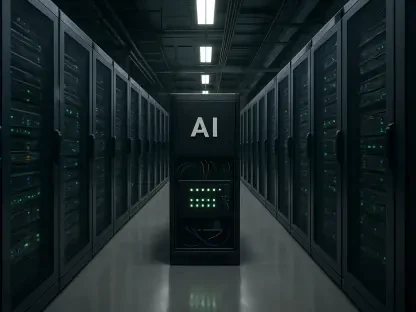In the current cybersecurity landscape, Managed Security Service Providers (MSSPs) are increasingly integrating Artificial Intelligence (AI) to enhance their services and address evolving threats. This article explores how MSSPs are leveraging AI to provide advanced threat detection, compliance support, and round-the-clock response, making them indispensable partners for organizations seeking robust security solutions.
Advanced Threat Detection with AI
Machine Learning Algorithms
MSSPs are deploying machine learning algorithms to analyze vast amounts of data and identify patterns that signal potential security threats. These algorithms learn and adapt over time, becoming more proficient in detecting anomalies that could indicate malicious activities. By continuously monitoring network traffic and system behaviors, machine learning algorithms provide a dynamic approach to recognizing cyber threats that traditional security measures might miss. The constant refinement of these algorithms ensures that the systems become increasingly accurate, reducing false positives while improving detection rates.
Moreover, the use of advanced machine learning techniques allows MSSPs to customize threat detection models to fit the specific needs of different organizations. This adaptability is crucial, as it enables security measures that are uniquely tailored to handle the myriad of threats faced by various industries. As cyber threats continue to evolve, the capacity of machine learning algorithms to self-improve ensures that AI-driven security systems remain one step ahead, providing robust protection for organizations of all sizes.
Predictive Analytics
Predictive analytics powered by AI enables MSSPs to foresee potential cyberattacks before they occur. By analyzing historical data and trends, AI helps in forecasting threats, allowing organizations to take preemptive measures to mitigate risks. These predictive capabilities are vital for identifying patterns that might suggest an impending attack, giving MSSPs and their clients the advantage of time.
The utilization of predictive analytics offers a proactive stance in cybersecurity, moving beyond mere detection to anticipating future threats based on existing data. By harnessing this information, organizations can implement defensive strategies and security measures tailored to counteract anticipated attacks. This forward-thinking approach not only strengthens security postures but also helps in optimizing resource allocation by focusing efforts on the most plausible threats.
AI-Driven Incident Response
Automated Response Workflows
AI-driven tools are automating incident response workflows, significantly reducing the time required to react to security incidents. This automation not only accelerates response times but also ensures consistent and reliable handling of threats. By automating routine processes, MSSPs are able to manage incidents more efficiently, minimizing potential damage and accelerating recovery processes.
Automated response workflows powered by AI are particularly effective in managing the initial stages of a security incident. These workflows can automatically isolate affected systems, initiate threat mitigation protocols, and alert human operators as necessary. This rapid response mechanism is essential for limiting the spread of any cyber incidents and ensuring that threats are contained quickly. Organizations benefit from reduced downtime and minimized impacts, as automated systems handle repetitive tasks, allowing human analysts to focus on more complex aspects of threat resolution.
Real-Time Mitigation
Real-time attack mitigation facilitated by AI allows MSSPs to neutralize threats as they unfold. By continuously monitoring and analyzing network traffic, AI systems can detect and respond to threats instantly, minimizing the impact on organizations. This real-time capability is crucial in the ever-evolving cybersecurity landscape, where the speed of response can make all the difference in containment and mitigation.
The ability to conduct real-time mitigation ensures that threats are addressed at the earliest stage, preventing further escalation. This immediate action is vital for maintaining the integrity and security of an organization’s data and systems. Moreover, real-time mitigation powered by AI ensures that responses are timely and precise, leveraging data-driven insights to apply the most effective countermeasures. Such efficiency not only enhances security but also fosters greater confidence among clients in the MSSP’s ability to manage and neutralize cyber threats promptly.
Enhancing Compliance and Risk Management
Compliance Support
AI technologies assist MSSPs in ensuring compliance with various regulatory frameworks by continuously monitoring systems for adherence to policies and standards. This support is crucial for organizations that must meet specific compliance requirements in their operations. Regulatory compliance can often be a complex and time-consuming process, but AI-driven solutions streamline this by automating monitoring and reporting functions.
By leveraging AI, MSSPs can provide comprehensive compliance assessments, identifying gaps and recommending necessary adjustments. This advanced monitoring ensures that organizations are consistently adhering to regulatory requirements, thus avoiding potential penalties and maintaining their reputations. The proactive identification of compliance issues is indispensable for businesses operating in industries with stringent regulatory environments, providing them with the assurance that their operations remain within legal boundaries.
Risk Prioritization
Risk prioritization using AI helps MSSPs assess the severity of threats and allocate resources accordingly. By understanding which threats pose the greatest risk, MSSPs can focus their efforts on mitigating the most critical vulnerabilities. The use of AI enables MSSPs to analyze complex datasets and identify the highest-risk scenarios, ensuring that resources are effectively utilized to protect against significant threats.
This prioritization process is crucial for optimizing security measures. Organizations are better positioned to deploy their resources in a manner that addresses the most pressing risks first, thereby enhancing overall security postures. AI-driven risk prioritization empowers MSSPs to provide more accurate and strategic advice, guiding clients in adopting the most effective measures to safeguard their digital assets.
AI and Extended Detection and Response (XDR)
Integrating XDR with AI
Extended Detection and Response (XDR) platforms are being enhanced with AI capabilities to offer a more comprehensive approach to cybersecurity. AI helps in correlating data across different security layers, providing a holistic view of an organization’s security posture. By unifying various security functions, AI-driven XDR solutions ensure seamless integration and coordination across endpoints, networks, and cloud environments.
The integration of AI with XDR enables MSSPs to detect and respond to threats with greater accuracy and speed. The cohesive analysis of data from diverse sources offers a more complete understanding of potential vulnerabilities and attack vectors. This interconnected approach ensures that no part of the security infrastructure operates in isolation, leading to more robust and coherent defense mechanisms.
Threat Intelligence Modeling
AI-driven threat intelligence modeling enriches XDR capabilities by producing actionable insights. By leveraging AI to interpret large volumes of threat data, MSSPs can offer more precise and actionable intelligence to their clients. This modeling involves analyzing vast datasets to identify emerging threats and trends, helping organizations stay ahead of potential risks.
The continuous evolution of threat landscapes necessitates adaptable and intelligent solutions. AI-powered threat intelligence modeling equips MSSPs with the tools to understand and predict new threats, offering tailored insights that can be seamlessly integrated into overall security strategies. These insights are critical for informing decision-making processes and ensuring that security measures remain effective against new and sophisticated cyber threats.
The Role of AI in Security Operations Centers (SOCs)
SOC Automation
In Security Operations Centers (SOCs), AI is automating routine tasks, thus allowing security analysts to focus on more complex issues. This automation boosts efficiency and helps in managing large-scale security operations more effectively. By handling repetitive and time-consuming tasks, AI frees up human resources, enabling analysts to engage in deeper, more nuanced analysis of security threats.
SOC automation powered by AI enhances the overall productivity and effectiveness of security teams. By streamlining processes such as log analysis, threat detection, and incident reporting, AI ensures that SOCs operate more smoothly and efficiently. The use of AI also reduces the likelihood of human error, enhancing the reliability of security operations and ensuring consistent protection across all monitored systems.
Expert-Led AI Services
In today’s cybersecurity landscape, Managed Security Service Providers (MSSPs) are increasingly incorporating Artificial Intelligence (AI) to boost their services and tackle emerging threats. This article delves into the ways MSSPs use AI for advanced threat detection, compliance support, and continuous response, establishing them as vital partners for firms aiming for strong security solutions. With AI, MSSPs can analyze large volumes of data quickly, identify patterns, and predict potential security incidents before they happen. AI tools help in automating routine tasks, freeing up human analysts to focus on more complex issues. Compliance with regulatory standards is another critical area where MSSPs leverage AI to automate monitoring and reporting, ensuring organizations meet legal requirements effectively. By offering 24/7 monitoring and rapid response, MSSPs equipped with AI provide a comprehensive security solution. These enhanced capabilities make them indispensable for businesses striving to protect their data and maintain robust cybersecurity defenses in an increasingly digital world.









